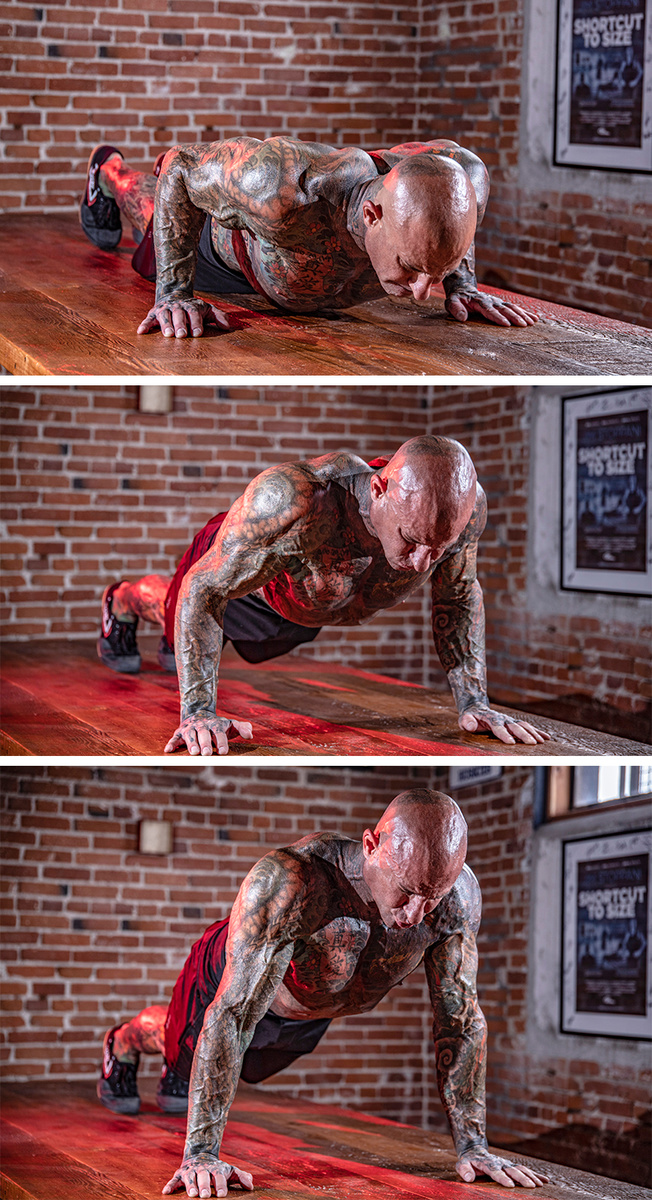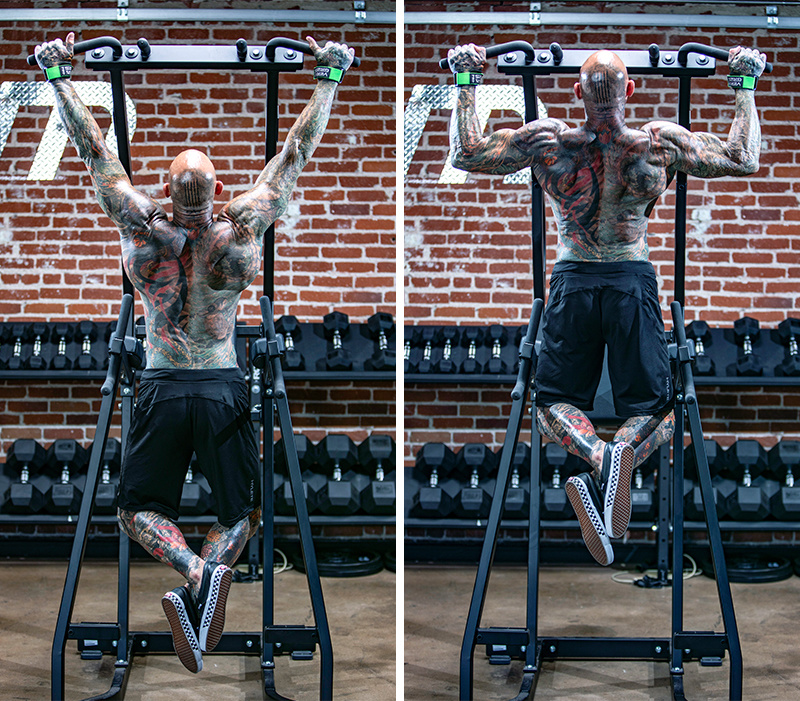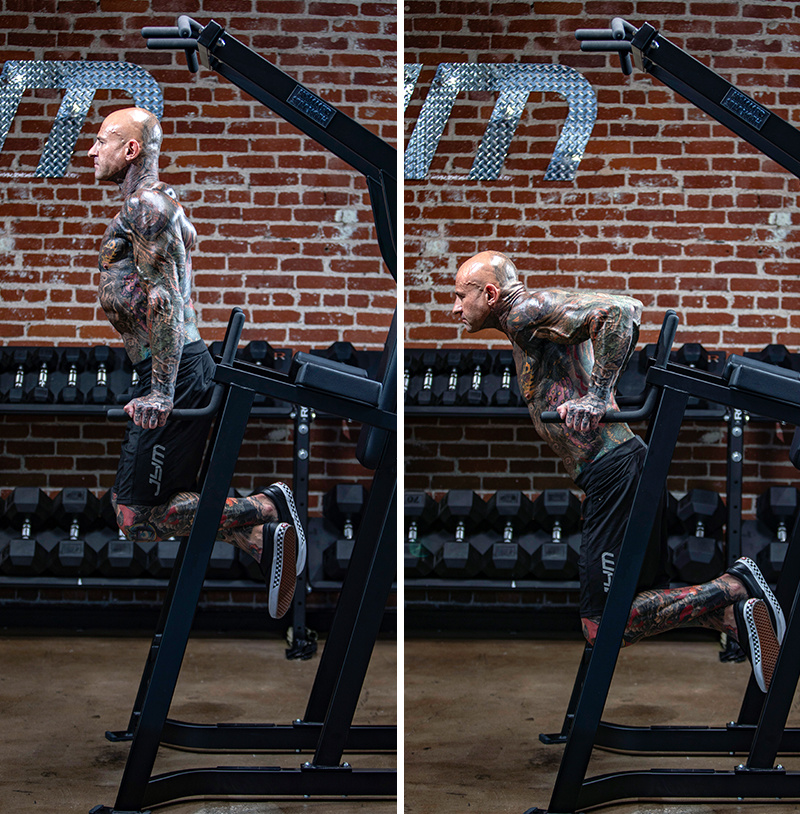Density Training Program
Do more reps on bodyweight exercises like pull-ups, push-ups, and dips with this weekly density training routine.

Do more reps on bodyweight exercises like pull-ups, push-ups, and dips with this weekly density training routine.

Most people would love to be able to bang out more reps on bodyweight exercises like push-ups, pull-ups, and dips.
These are classic movements, after all, popularized by our great soldiers in the military; impressive athletes like boxers, mixed martial artists, and gymnasts; and even the "Italian Stallion" himself, Rocky Balboa!
These exercises aren't necessarily the best measures of pure strength. It's actually "strength-endurance" that they test, since the goal is to complete the most reps possible. That said, calisthenic exercises are great for building muscle, gaining functional strength that carries over into the real world, and even developing some grit. Best of all, bodyweight movements are convenient and can be done with little to no equipment, making them ideal for times when you're stuck at home or traveling with only a bare-bones hotel gym at your disposal.
As basic as these exercises are, however, they're not easy. Many fit people are able to bang out at least 5-10 pull-ups, 10-20 dips, and 20-30 push-ups, but at some point you hit a ceiling that won't seem to budge. Once you're stuck at a number, it can get frustrating.
So how do you break through a stubborn barrier to where you can do more consecutive reps of push-ups, pull-ups, dips, or other bodyweight moves? I have one proven method for this: density training.

Density training is a technique I like to use for bodyweight exercises, where you complete more reps of the exercise in less time over the course of a weeks-long (or months-long) program.
Let’s say you’re weak at push-ups and have a goal to work up to 20 consecutive reps. Here's how the density training protocol would look...
First of all, your rep goal in each workout will be to complete double the number of reps as your goal – so in this case, 40 push-ups per density training workout. Why 40 instead of your goal of 20? Because if your goal is to do 20 consecutive push-ups, you’ll want to overshoot that in your workouts to build the necessary muscular endurance. If your goal was 10 straight pull-ups, you'd do 20 pull-ups total per workout. If it was 30 dips, you'd do 60 total. And so on.
And how will you do that, seeing is that you’re not even doing 20 reps consecutive? (Or 10 or 30 reps, depending on the specific goal.) By resting throughout the workout. Yes, it’s 40 push-ups, but not consecutive.
You’ll start in Phase 1, where you’ll break up the 40 total reps of push-ups into 10 sets of 4 reps. And there’s a time limit here: You have 10 minutes to complete the 10x4 set/rep scheme.
With the same number of sets as minutes allowed (10), it’s pretty easy to figure out how you’ll do this. At the start of each minute, do 4 push-ups, then rest the remainder of the minute (50 seconds or so) until the top of the next minute, when you’ll do the next 4 reps. CrossFitters would call this an EMOM, short for each “each minute on the minute.” This EMOM format will be present in all phases of the density training program, regardless of your rep goal.
Once you’re able to get all 40 reps done in 10 minutes or less (doing 4 reps at the top of each minute), you’ll move onto Phase 2. As the phases progress, you’ll do the same 40 total reps, but in less time; this means you’ll be doing fewer sets, more reps per set, but with shorter rest periods.
In Phase 2, for example, you’ll have 8 minutes to do 40 push-ups. You’ll break that down into 8 sets of 5 reps. Again, do this as an EMOM. At the top of each minute, do 5 reps, then rest for the remainder of the minute. Once you’re able to complete all 40 reps in 8 minutes or less, you can move on to Phase 3.
The phases do NOT have time limits in terms of how many days or weeks to stay in a given phase. Each phase will last as long as it takes you to achieve the prescribed reps.
Using the 20 push-ups goal as an example once again, if the first time you do the Phase 1 workout you’re not able to complete all 10 sets of 4 reps within 10 minutes, that’s fine. Maybe you got the 4 reps up until the fifth or sixth round, but then fell off and couldn’t get to 40 total reps in 10 minutes. If that’s the case, the next time you do the push-up density workout, you’ll repeat the Phase 1 workout with a goal to get closer to 40 reps in the allotted 10 minutes.
Once you’re able to do all 10 sets of 4 reps in under 10 minutes, it’s time to graduate to Phase 2. If this takes you 2 weeks, fine. Or 3 weeks or 4 weeks or 5 weeks, whatever.
The reason I mention this is that I don't want you to get discouraged if it takes you more than a week to get through a phase. You may look at one of the below density programs, see that it's, say, six phases long, and assume that it's a 6-week program. For some people maybe it is, but for most people it will take longer.
Don't rush it. Go at your own pace.
Here's the complete Density Training program for a goal of doing 20 consecutive reps of a given exercise. This is consistent with the 20 push-ups example I've been using, but it would also work for a goal of 20 straight pull-ups, 20 dips, or even 20 handstand push-ups.
| Phase | Sets | Reps | Time Allotted | Total Reps |
|---|---|---|---|---|
| 1 | 10 | 4 | 10 minutes | 40 |
| 2 | 8 | 5 | 8 min. | 40 |
| 3 | 7 | 6 | 7 min. | 42 |
| 4 | 6 | 7 | 6 min. | 42 |
| 5 | 5 | 8 | 5 min. | 40 |
| 6 | 4 | 10 | 4 min. | 40 |
Once you complete Phase 6 (if not sooner), you should be able to do 20 reps consecutively.
To see how you’re progressing toward your goal (in this case, doing 20 consecutive reps of the chosen exercise), do an informal max-rep test after completing each phase.
Using push-ups as an example, once you complete Phase 1 (where you’re able to do 40 reps in 10 minutes or less), wait a couple of days, and in a separate workout see how many consecutive push-ups you can do.
How many phases it takes to hit your 20-rep goal will vary from person to person. Some people will find that once they can do 6 sets of 7 reps in 6 minutes (completing Phase 4), they can do 20 reps consecutively. Yet others may find they’re not quite to 20 at that point and need to move on to Phase 5 to continue progressing toward their goal.
That said, Phase 6 should be the final stopping point for just about everyone. Once you’re able to do 4 sets of 10 reps in 4 minutes or less, you should definitely be able to do 20 straight reps of the exercise.

I recommend doing density training workouts on days you're training the affected muscle group. So, if it's density training for push-ups, do it on chest day. If it's dips, do it on chest day or triceps day (or better yet, a chest and triceps day). If it's pull-ups, do it on back day. And always do the density training routine at the beginning of the workout when your muscles are at their freshest.
Or, do the density training routine on a completely different day, at least 2-3 days after your previous workout for the muscle group.
For best results, do the density workout 2 times per week. You can opt to do it only once a week if you like, but at twice weekly you’ll reach your goal a bit faster.

In the above example, I used a goal of 20 consecutive push-ups. However, many JYM Army members are probably already doing 20 fairly easily. Getting up to 40, or 60, straight push-ups is a different story.
On the other hand, if you're doing dips or pull-ups (which are more difficult than push-ups), you may need to set a goal of 10 or 20 reps.
The density training program can accommodate any rep goal on pretty much any exercise with a simple tweak to the above sets, reps, and time.
Whatever your rep goal is, double that number, and that’s how many total reps you’ll do in each workout. So, if 40 push-ups straight is the goal, you’ll do 80 push-ups per density workout, 1-2 times per week; if the goal is 10 pull-ups, you’ll do 20 reps per workout.
As with the 20-rep example, each phase will see the number of sets and time decrease and the number of reps per set increase. The number of reps per workout will stay roughly the same throughout. (There are instances where the total reps in a workout don't hit exactly 20, 40, 60, 80, or 100; this is only because the number of sets doesn't go evenly into the total number of reps.)
To make it easy for you, here are the protocols for goals of 10, 30, 40, and 50 reps consecutive, regardless of the exercise. For 60 reps, use the chart at the bottom of my Fitter, Faster, Leaner Program Overview article.
| Phase | Sets | Reps | Time Alloted | Total Reps |
|---|---|---|---|---|
| 1 | 10 | 2 | 10 minutes | 20 |
| 2 | 8 | 3 | 8 min. | 24 |
| 3 | 6 | 4 | 6 min. | 24 |
| 4 | 4 | 5 | 4 min. | 20 |
Once you complete Phase 4 (if not sooner), you should be able to do 10 reps consecutive.
| Phase | Sets | Reps | Time Alloted | Total Reps |
|---|---|---|---|---|
| 1 | 10 | 6 | 10 minutes | 60 |
| 2 | 8 | 8 | 8 min. | 64 |
| 3 | 7 | 9 | 7 min. | 63 |
| 4 | 6 | 10 | 6 min. | 60 |
| 5 | 5 | 12 | 5 min. | 60 |
| 6 | 4 | 15 | 4 min. | 60 |
Once you complete Phase 6 (if not sooner), you should be able to do 30 reps consecutive.
| Phase | Sets | Reps | Time Alloted | Total Reps |
|---|---|---|---|---|
| 1 | 10 | 8 | 10 minutes | 80 |
| 2 | 8 | 10 | 8 min. | 80 |
| 3 | 7 | 12 | 7 min. | 84 |
| 4 | 6 | 14 | 6 min. | 84 |
| 5 | 5 | 16 | 5 min. | 80 |
| 6 | 4 | 20 | 4 min. | 80 |
Once you complete Phase 6 (if not sooner), you should be able to do 40 reps consecutive.
| Phase | Sets | Reps | Time Alloted | Total Reps |
|---|---|---|---|---|
| 1 | 10 | 10 | 10 minutes | 100 |
| 2 | 8 | 13 | 8 min. | 104 |
| 3 | 7 | 15 | 7 min. | 105 |
| 4 | 6 | 17 | 6 min. | 102 |
| 5 | 5 | 20 | 5 min. | 100 |
| 6 | 4 | 25 | 4 min. | 100 |
Once you complete Phase 6 (if not sooner), you should be able to do 50 reps consecutive.
As I've said throughout, the density training protocol works well for any bodyweight exercises – push-ups, pull-ups, dips, sit-ups, you name it. But it can also be used for non-bodyweight exercises.
For example, the NFL Combine 225-pound bench press test. Let’s say you have the lofty goal of getting 20 reps on bench with 225 pounds (you would have to be a pretty advanced lifter to have this goal). Follow the exact same density protocol as I outlined above for 20 consecutive reps, with one important caveat: You’ll need a spotter close by for the times you fail on a set during the workout.
You can also use the density program for other lifting exercises like squats. Maybe you have a goal of getting 225 or 315 on squats for 20 reps. It works for any number of things.
I highly recommend my Density Training program anytime you want to increaese your max reps on any exercise, bodyweight or otherwise.
Enjoy being able to bang out more pull-ups, push-ups, dips, or reps of 225 on bench!
Related Articles